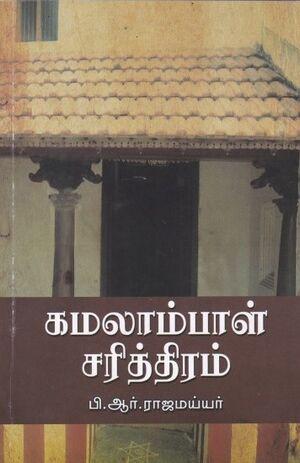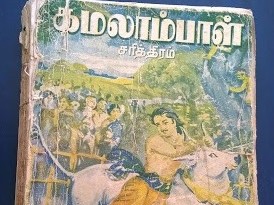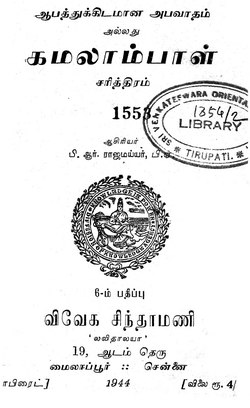Kamalambal Charithiram
🔏Being Created-en
Please do not write any content below this line. This section is only for editing templates & categories.
இந்தப் பக்கத்தை தமிழில் வாசிக்க: கமலாம்பாள் சரித்திரம்
Kamalambal Charithiram, known to be the second novel in Tamil, was written in 1893 by B.R Rajam Iyer. This was the first serialized Tamil novel. This was also the first novel in Tamil where the protagonist is a woman and the title of the novel is that of a woman. Critics also credit it as being the first realistic novel in Tamil that is written without any influence of English novel writing styles. It is considered to be a novel of artistic significance due to its elaborate characterization, psychological approach to the emotions of the characters, description of the novel events without over dramatization in addition to its humor.
Creation
B.R Rajam Iyer started writing the novel as a serial in February 1893 in the monthly magazine Viveka Cinthamani. The story was serialized over three years with the title as Aniyaya Abavatham Allathu Kamalambaal Charithiram. It was published as a novel in 1896 with the title changed as Abathukkidamana Abavatham Allathu Kamalambal Charithiram.
When this story came in Viveka Cinthamani, the author was mentioned as B.R. Sivasubramania Iyer B.A. However, when it was published as a novel in 1896, author is mentioned as B.R. Sivasubramania Iyer alias B.R Rajam Iyer. In the subsequent editions, the name B.R. Sivasubramania Iyer is removed, and B.R Rajam Iyer alone is retained.
Rajam Iyer's views on philosophy are Vedantic and directed towards inner self. He tries to find intellectual solutions for social problems. He gives importance to a life focusing on realizing God within oneself. Rajam Iyer says that the main aim of this novel is to describe the final attainment of a state of pure bliss by a restless soul suffering and struggling in this world.
Publication
The novel, which was serialized in Viveka Cinthamani magazine from 1893 to 1896, was first published as a book on behalf of Viveka Cinthamani in October, 1896. The editor of the Viveka Cinthamani magazine, V.V. Swaminathayyar had written the Introduction for the first edition. The second edition of the novel came in February 1904 followed by subsequent editions in the years 1910, 1915, 1930. Having seen six editions by the year 1944, the novel went on to have many more editions in the later years. The Madras University had prescribed the novel as a textbook for their Teachers Certificate course.
Synopsis
The novel has two parts. The first part has 17 chapters and the second part has 20 chapters.
Muthuswamy Iyer lives in a village called Sirukulam in Madurai district. His wife is Kamalambal. They have a daughter, Kalyani alias Lakshmi. Kamalambal and Muthuswamy Iyer loved each other deeply. Subramania Iyer is the younger brother of Muthuswamy Iyer. Ponnammal is the wife of Subramania Iyer and they have a son named Sundaram. Subramania Iyer holds deep respect and love for his elder brother. However, he is obedient to his wife. Ponnammal was the head of the village’s chatters association. Muthuswamy Iyer’s family is one among the influential families of the area. Muthuswamy Iyer and Kamalambal finalize and fix the marriage of Kalyani to Srinivasan from Madurai. Ponnammal had been desiring to marry Kalyani to her brother’s son and she gets angry when her desire goes unfulfilled. She prevents her husband from attending Kalyani’s betrothal function. However, the marriage happens successfully. After some days, Kamalambal gives birth to a male child. They name him Natarajan.
Meanwhile, Komala Nayakkanur Zamindar develops hatred towards Subramania Iyer due to a rivalry that developed between them during Jallikattu. Due to the animosity, the Zamindar engages a thief called Peyandi Thevar to go to Subramania Iyer’s home for stealing all their jewels and the bull that will be participating in Jallikattu. Muthuswamy Iyer files a case against Peyandi Thevar on behalf of his brother. Succumbing to the charming medicine given by his wife, Subramania Iyer stands as a witness in favor of Peyandi Thevar. Still Peyandi Thevar gets convicted. After spending two years in prison, Peyandi Thevar on getting released from prison, kidnaps Muthuswamy Iyer’s two year old child and sells the child to Ramaseshayyar. The Family of Muthuswamy Iyer lose all their peace and happiness having been parted from their child.
Srinivasan, Muthuswamy Iyer's son-in-law travels to Madras for pursuing his studies. Muthuswamy Iyer and Kamalambal relocate to Madras to live with their daughter. One day, on receiving a telegram informing of the illness of his brother, Muthuswamy Iyer travels to Sirukulam with Kamalambal to see his brother. Subramania Iyer breathes his last while asking for his brother’s pardon. Meanwhile, the business in which Muthuswamy Iyer had invested suffers losses. He begins to hate the worldly life and starts wandering in search of peace. Ponnammal along with the ladies of the chatters association, spreads rumors on Kamalambal’s morality and triggers a separation between Muthuswamy Iyer and Kamalambal. Becoming totally depressed, Muthuswamy Iyer tries to commit suicide. He gets the experience of God while trying to commit suicide. Satchithananda Swamigal becomes his guru. Both of them travel to Kasi.
Ponnammal becomes mad after the death of Subramania Iyer. Vaidyanatha Iyer, a judge and friend of Muthuswamy Iyer, gets to know of the betrayal of Kamalambal by Ponnammal. Kamalambal travels to Kasi along with her daughter and son-in-law, in search of Muthuswamy Iyer. Finally, a repenting Peyandi Thevar and Natarajan also reach Kasi. Everyone reunite amidst the search. Satchithananda Swamigal directs Muthuswamy Iyer to be an ascetic even while leading a family life. Kamalambal starts meditation on Rama.
Characters
Kamalambal: Protagonist. A lady who always adjusts patiently with others. Love, humility and deference are attributes that are always present as part of her nature.
Muthuswamy Iyer: Kamalambal’s husband. A person of noble character always ready to help anyone in need. Involved in Vedanta.
Kalyani / Lakshmi: Daughter of Muthuswamy Iyer and Kamalambal.
Subramaniya Iyer: Younger brother of Muthuswamy Iyer. He has lot of respect and love for his brother. An obedient husband.
Ponnammal: Wife of Subramania Iyer. A woman filled with greed and arrogance. She is always ill advised by the female members of the village’s chatters association.
Sundaram: Son of Subramania Iyer and Ponnammal.
Adusapatti Ammayappa Pillai: Tamil teacher. A typical representative of scholars who the world is ignorant of in-spite of speaking in a manner which is not understood by others and having sung many songs. He saves Kamalambal from a train accident.
Critical assessment
Even though Pradhaba Mudhaliar Charithiram written by Mayuram Vedha Nayagam Pillai and published in 1879 is accepted as the first novel in Tamil, many critics agree that Kamalambal Charithiram qualifies to become the first novel in Tamil when the evaluation criterion includes the literary form of the novel, characterization, elegance of the story narration and the structure of the novel.
Even at a time when the prose writing in Tamil language had not evolved properly, Kamalambal Charithiram was a literary novel that fitted well into the grammatic definition of the novel form of literature. Poetry, folk tales, mythical stories were in vogue during those times when it was strongly believed that books existed mainly for sharing of knowledge and as a channel for moral teaching. Hence there was a compulsion on any book written to be explicitly teaching morality and justice. The introduction to the books themselves should indicate this objective. Moreover, this was a period when India was awakening to Modernism. Due to this, the educationalists were mostly reform minded. Therefore, the prose in all Indian languages were written mainly as a campaign for reforms. Novels like Padmavathi Charithiram by Madhavayya are examples of this trend. But Rajam Iyer had transgressed all such boundaries.
Writer Jeyamohan says that this is a novel where there is no propaganda of opinions, contains subtle humor and character delineation. He indicates that Kamalambal Charithiram is a superior novel among the top rated novels in all Indian languages while highlighting that a depiction of a fine psychological perspective also exists in the novel.
"If we ask ourselves "which novel leads over all other novels ever published until today?" we can without doubt say that it is Kamalambal Charithiram. Tamil novel writing is progressing like a flame in the path of Kamalambal Charithiram that the." says poet Na. Pichamurthy.
"Through his single novel Kamalambal Charithiram, B.R Rajam Iyer has the fame of becoming accepted unanimously as the best novel writer of this century. The first edition of this novel has been published during his time itself. We are yet to receive a Tamil novel that can be compared with Kamalambal Charithiram. ". This is the praise for the novel by writer Si.Su Chellappa.
"Let me tell emphatically in the beginning itself that among the new Tamil prose creations, Rajam Iyer's Kamalambal Charithiram is the one I love the most" says Tamil researcher Kamil Zvelebil.
Kamalambal Charithiram has been well appreciated by many learned Tamil scholars including Manonmaneeyam P Sundaram Pillai, B.S Ramaiya. It has also been commended by reputed magazines of that time like Dinamani, Swadesamitran, Siddhanta Deepika, The Madras Mail, Indian Social Reformer.
The second part of the novel fully deals with Vedanta inquiry directly. This has been highlighted as an artistic shortcoming by critics. The novel is considered as a master piece mainly for the artistic portrayal of life in the first part. The novel is especially noteworthy for its treatment of realism.
Translations
Kamalambal Charithiram novel was selected by an United Nations to be translated as part of the world cultural series in 1950. The English translation of the novel was prepared. Subsequently the translation was lost when the cultural series plan was dropped.
Author Stuart H. Blackburn researched the novel for many years and in 1999, had Oxford University Press publish the translation with the title The Fatal Rumor. He had included many foot notes and a glossary as part of this edition. The translation won the A.K Ramanujan award for translation works in 2000.
References
Birth and growth of Tamil Novel literature: Ki.Va Jagannathan



